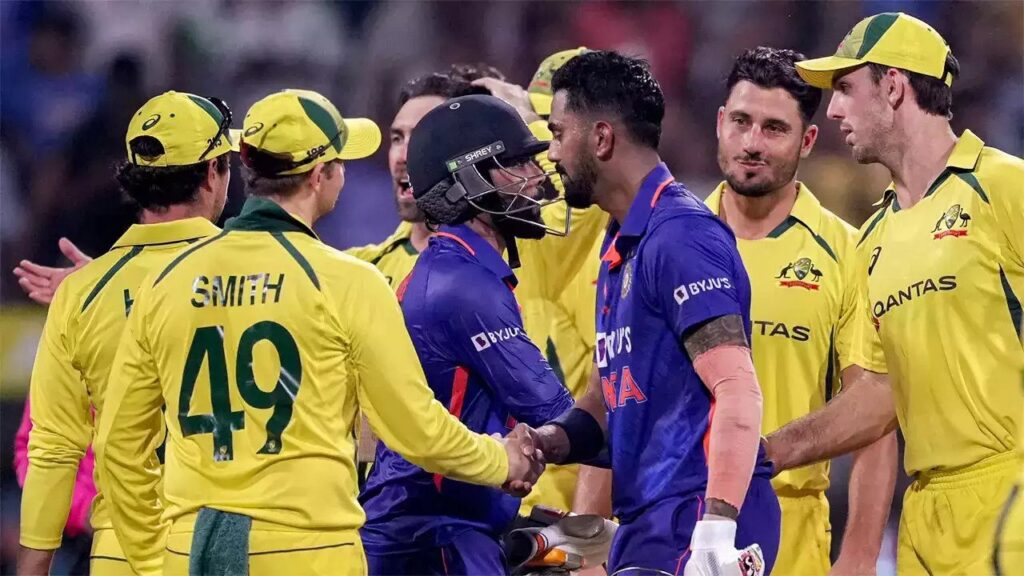Post-Series Analysis: India vs Australia (ODI)

India lost 1-2 in their 3-game home ODI series against Australia. Certain events in the series prompted praise (like India’s thumping win in the first ODI), while others promoted scrutiny of the Indian team and management. Here are highlights from each match:
Match 1:
India won the toss and decided to bowl first. India broke through early, with Mohammad Siraj clean-bowling Travis Head in the second over. Steve Smith and Mitchell Marsh then set up a 72 run partnership spanning ten overs, bringing Australia to 77 before KL Rahul gloved an edged ball bowled by Hardik Pandya to Smith. Australia continued strong with Marsh taking the lead with runs until Marsh edged a flighted ball by Jadeja, resulting in a simple catch for Mohammad Siraj at short third man. After Marsh departed, Australia fell like a sack of potatoes, getting bundled out for 188 runs.
India started very shakily, losing Ishan Kishan (3(8)), Virat Kohli (4(9)), Suryakumar Yadav (0(1)), and Shubman Gill (20(31)) before hitting the fifty run mark. Hardik Pandya and KL Rahul steadied the ship, bringing India to the 83 run mark before Pandya was caught out at the boundary. Jadeja then came in and formed a 108 run partnership with KL Rahul to ease India across the finish line.
India’s colossal top-order collapse was a big spot of worry in this match. Suryakumar Yadav’s golden duck was also a big spot of worry as it substantiates a below-par ODI career for the celebrated T20 batsman.
Match 2:
Australia won the toss and decided to bowl first. The Aussies struck early, getting Shubman Gill out in the first over. Kohli and Rohit Sharma then began forming a partnership, adding 32 runs in just four and a half overs, but that ended when Sharma got out in the late fourth over. From there, India collapsed, losing a wicket for every ten or fifteen runs. India ultimately got bundled out for just 117 runs in 26 overs.
Travis Head and Mitchell Marsh came into the second half of the game in a hitting mood, and their batting reflected. Mitchell Marsh scored 66 runs off 36 balls while Travis Head scored 51 runs off 30 balls, and they reached the target of 118 in just 11 overs. Australia won by 10 wickets with 234 balls remaining – one of India’s biggest, most crushing defeats at home.
India’s top and middle order collapse in this second ODI is a huge concern. The fact that seven internationally-reputed batsmen couldn’t get a single decent partnership going is absolutely outrageous and it might be a hint that these batsmen are overvalued. The only run-scorers in this match were Virat Kohli (31(35)) and Axar Patel (29(29)). Another huge concern is the Indian pace attack’s lack of teeth in this match. Much unlike their Australian counterparts, pacers Mohammad Shami, Mohammad Siraj, and Hardik Pandya weren’t able to restrict the Australian run flow, and this indicates that the balls bowled lacked the proper length, pace, and swing. India’s high reliance on a good swinging pitch to take wickets could be a huge problem for the team in upcoming matches.
Match 3:
Australia won the toss and decided to bat first. The Aussies got off to a good start, reaching 50 runs within the first ten overs without the loss of any wickets. Pandya then struck for India in the penultimate ball of the tenth over, dismissing Travis Head. Steve Smith quickly fell prey to Pandya again in the twelfth over, and from there partnerships formed and broke at an almost steady rate. Almost every Australian batsman scored over twenty runs, but just as a partnership was about to form the Indians struck and took a wicket. Australia ended up all out for 269 runs in the 49th over.
India started off strong, with Rohit Sharma and Shubman Gill reaching the 50-run mark within the first nine overs. Sean Abbot and Adam Zampa then struck consecutively, dismissing Sharma and Gill in the ninth and twelfth overs respectively. Kohli and KL Rahul then began a slow rebuild. Their partnership lasted for almost 80 runs. But just as things looked bright for India, KL Rahul was caught at the boundary by Zampa. A terrible mixup in the next over resulted in Axar Patel being run out. Pandya and Kohli then formed a partnership for 34 runs before Kohli got dismissed cheaply after attempting an inside-out shot. Jadeja then came to the crease, and he and Pandya brought India to 225 before Pandya got caught due to the brilliant field placing by Australian captain Steve Smith. From there, India lost all hope, ultimately ending up all out for 248 runs in the 49th over.
India’s lack of partnerships in the third ODI is a concern for the team management, as partnerships are crucial in this format to achieve high batting totals. Despite having world-class batsmen like Rohit Sharma, Virat Kohli, KL Rahul, Hardik Pandya, and Ravindra Jadeja, India wasn’t even able to hit 250 runs on a home pitch – it almost doesn’t make sense. This series has displayed the Indian team’s lack of consistency and that is a huge spot for worry in regards to the looming ODI World Cup.
Some Important Observations from This Match:
India is inconsistent in their performances with both the bat and ball (as exemplified by their thumping win in the first ODI followed by thumping losses in the second and third ODIs). India possessed the home ground advantage for all three ODIs, and the fact that they couldn’t take advantage of that knowledge could be reflective of a strategic mindset that requires tweaking.
Suryakumar Yadav is now the first Indian player to get three consecutives golden ducks in an ODI series. In the first two games, he couldn’t read Mitchell Starc’s swing, which coupled with his nature of playing the ball against its angle resulted in him being plum LBW’d. In the third game, he didn’t correctly read Ashton Agar’s spin and attempted to cut it to third man. However, he was left red-faced when the ball flew inches away from his bat and hit the off-stump. Surya’s countless chances to perform in ODIs is puzzling, especially considering he is occupying a spot that could be filled by Sanju Samson, who has performed for India in numerous ODI matches but got benched for no reason.
Hardik Pandya captained the Indian squad in the first ODI, and the strategic thinking he displayed seemed to be a lot more fitting to the Indian team’s strengths than Rohit Sharma’s strategies in the second and third ODIs. For example, Pandya set his fielders in slightly unorthodox positions and brought in spin early, which resulted in certain key wickets coming quickly for the Men in Blue. Pandya seems to possess a better acumen for captaincy than Rohit Sharma, and him being at the forefront of the Indian attack could be key to winning the ODI World Cup.
After a series of disappointing innings, it seems KL Rahul has finally found some form. However, Rahul took some undue risks in all three ODIs, and while it didn’t affect the outcome of the first match, it could have had a major effect on the outcome of the second and third matches. Rahul looks like he wants to be an aggressive fourth down batsman, but it may not suit his batting style and elegance. Thus, there is a big question mark surrounding his inclusion in future Test and ODI matches.
With the looming ODI World Cup this October, the Indian team needs to be all guns blazing in their home bilateral series. The batting and bowling failures displayed in this ODI series should be a high priority of focus for Team India coach Rahul Dravid, and we all hope that India will come back stronger from this series.
